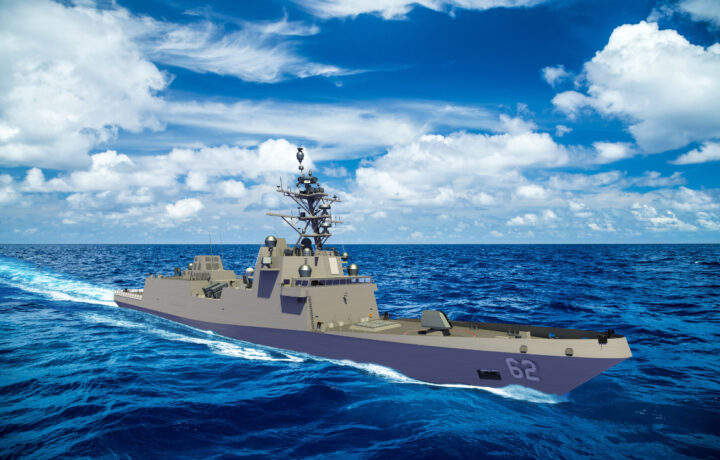There have been dire warnings that autonomous machines could threaten humanity, while for decades robots have been seen as a threat by taking jobs away from skilled workers. It would seem both views may be wrong – as specially-designed robots can take on jobs that are in high demand and ensure that that the critical components of the U.S. military are produced on time.
United States Navy’s fleet size
As reported last month, the United States Navy’s fleet size is now the smallest it has been since the First World War, and lawmakers continue to push for a naval expansion. However, adding to the woes is the fact that the United States now lacks the shipyards to build and maintain a sizeable fleet, and that problem is almost certainly going to get worse before it gets better.
At issue is that since the 1970s, 14 “defense-related shipyards” have been shuttered, while only one new shipyard has opened. In addition, the number of firms still in the shipbuilding sector has dwindled. But that’s just part of the problem.
It was two years ago that a Pentagon report warned that the shipbuilding “industrial base today lacks the resiliency and bench strength to meet required demand,” and it stressed the need for long-term, prioritized workforce investments. Simply put, the shipbuilding industry is facing an ongoing challenge to attract, train and retain skilled labor. Just as the U.S. military has struggled to fill its ranks, the shipbuilding industry is facing a very serious labor shortage. There are not enough new workers to replace those who are retiring.
Without the skilled labor, the shipbuilding industry is starting to get creative – and this could result in the true “rise of the machines.”
Navy Robots at Work
Though there have been those dire warnings that robots will take jobs, robots are needed to address a labor shortage.
Notably this includes shipbuilder Fincantieri, which is employing robots to aid in the building of the U.S. Navy’s new Constellation-class frigates, which are set to enter service by the end of the decade. The company is seeking to employ greater automation at its Marinette Marine yard, which would allow it to build two of the frigates every year instead of three every two years.
Just this past July, Fincantieri unveiled MR4Weld (Mobile Robot for Welding), a tracked welding robot it developed with Italian firm Comau, a platform that is already active in the automotive industry. Each robot is reported to be equipped with a welding torch, while the platform employs a video system which can autonomously identify welding joints or be told by a human operator where to weld.
“Designed and deployed to weld steel structures during the vessels’ building stage in the shipyards, the inherently flexible solution can be easily reconfigured to address other application areas and industries,” Comau stated in last year’s press release.
“Welding is one of the skills it is hard to find, while the robot welding we plan to introduce triples productivity and increases quality, Pierroberto Folgiero, the CEO of Fincantieri told Defense News this week.
Fincantieri Business Moves
Fincantieri acquired Marinette Marine 15 years ago, and is currently building the first Constellation-class frigate for the U.S. Navy with a planned completion date of 2026, part of an expected program of 20 vessels based on the FREMM frigate the firm had previously built for the Italian Navy.
Last summer, Fincantieri announced it would partner with Comau to strengthen and upgrade the technical skills of its operators in terms of using and programming the robotized mobile systems, by adapting to the shipbuilding operators’ dedicated advanced training formats, which are already developed by Comau.
MR4Weld is built around a high-payload, 6-axis articulated robot fitted with a welding torch that is installed on a tracked undercarriage and equipped with an integrated vision system to autonomously identify welding joints. It can autonomously weld steel structures, with a possible three-fold increase compared to a manual process – while also providing better welding quality and reducing ergonomic risks. A single operator can manage each MR4Weld during the transfer and welding activities. And it uses digital tools to collect welding and production data that can be used to record the welded joints.
The platform is in complete compliance with current safety regulations. The Navy can use it without fences on each of the multiple decks of a vessel.
Addressing Worker Shortage
MR4Weld won’t be putting welders out of a job. Far from it, as skilled welders remain in demand, and the welding industry expects to see a shortage of 360,000 trained individuals by 2027, according to the American Welding Society.
While the average age of an employee in the United States is 42, in the welding space, it is 55.
As Defense News further reported, at Fincantieri’s three Wisconsin yards – which currently directly employ 2,100 individuals – there is still a shortfall of 400 staff. The shortfall improved from just a year ago when it was at 1,000. In the past year, around 400 blue-collar and 150 management staff have been hired.
“We still have the problem of finding people, and, as importantly, retaining them with incentives,” said Folgiero.
Welding robots could be part of the solution, and automation is likely to increase in the shipbuilding sector.




